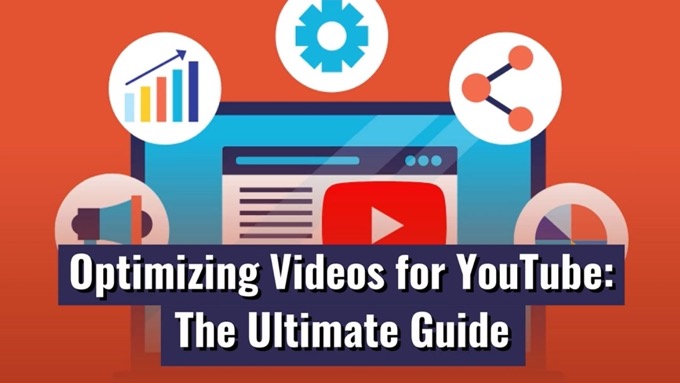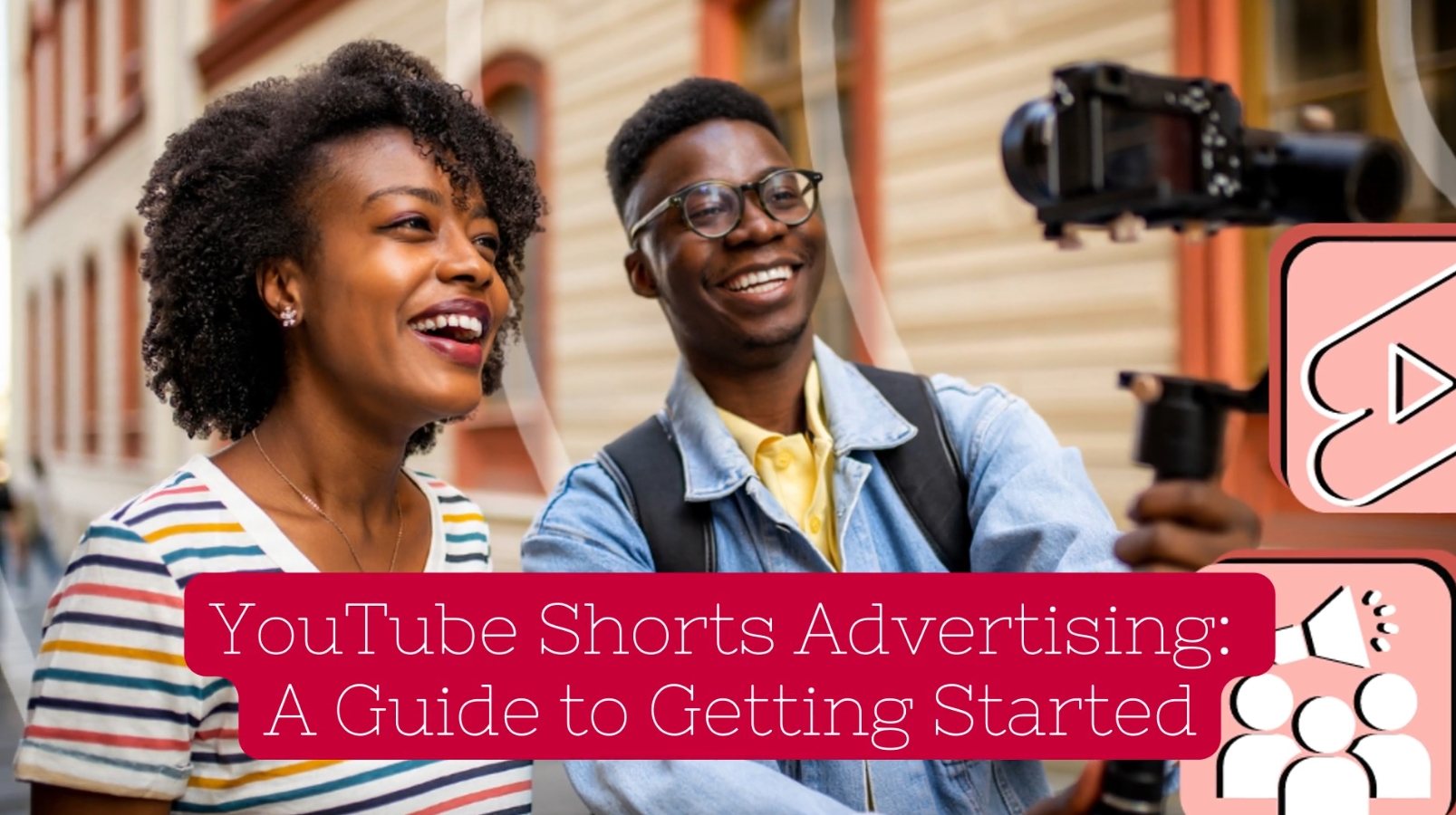We can't of course upload videos to YouTube, cross our fingers, and hope for the best if we want to see meaningful results.
Instead, optimizing them to help them get seen by our intended audience is essential.
So how do you go about optimizing videos for YouTube?
This post gives you everything you need to know, with 4 key steps to optimize videos on YouTube effectively...
Video Optimization Step #1: Keyword Research
The first step has to be keyword research.
It means you’re creating videos in the first place that are capable of ranking well and attracting traffic —on YouTube as well as potentially on Google Search—for relevant search terms people are actually using.
Effective YouTube video optimization starts with keyword research. It means you're creating videos based on what people are actually looking for.Click To Post OnHere are a couple of ways to approach it.
Use YouTube’s Suggested Search
Start by using YouTube’s search facility. Enter relevant keywords, and look for the related keywords that are suggested in the dropdown.

You can guarantee that keywords shown here reflect some of the most popular searches on Google related to the search term entered.
Try using ‘how to’ followed by a relevant keyword for your niche. 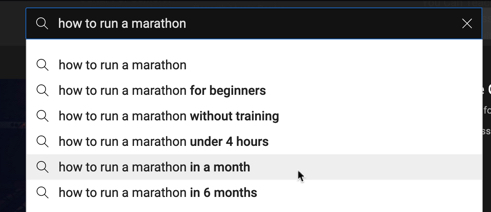
Write down potential keywords that look like a good fit for your niche.
Look at Relevant Popular Videos
Another way to find good keywords is to:
- Look at popular videos relevant to your own niche
- See what keywords they’re focusing on.
If these videos are getting a lot of attention, then you know that the keywords they focus on are likely to attract a lot of traffic.
Let’s say your niche is learning to play guitar.
So you search on YouTube for a keyword term like learn guitar.
You notice that many of the videos shown in the results reflect videos uploaded several years ago. So some of their popularity can be attributed to the amount of time the video's been on the platform, as well as the number of subscribers the channel has accrued over time.
To get the most recent results, and ensure that the keywords you find are the most relevant ones, you adjust the filters at the top to a recent period. 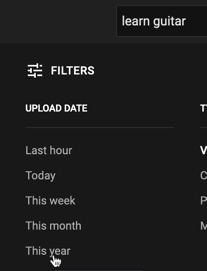
Searching for ‘learn guitar’ then brings up videos like the following. Note I’m using the vidIQ Chrome plugin which overlays some additional helpful data, including the number of channel subscribers. 
The top one for example has attracted several hundred views within just a month, and the channel only has a few thousand subscribers, so it’s likely many of those views came via search.
However, it’s not particularly well optimized, but it does provide a couple of keyword ideas such as cool riff and beginner guitar lesson. 
In contrast, the video at the bottom of the three shown above, is much better optimized and has attracted nearly 50,000 views in around a month (with over 400k subscribers to their channel). 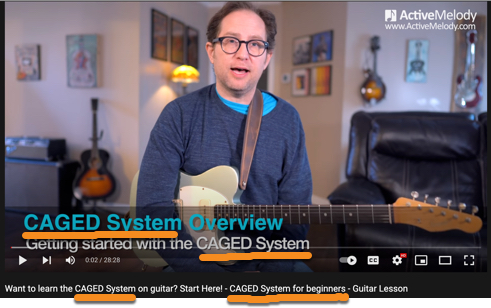
Here, the video is quite clearly targeting keywords like CAGED system, CAGED system on guitar and CAGED system for beginners.
More on how to optimize videos for YouTube for specific keywords shortly.
Check Competition Levels
Once you’ve got a list of potential keywords, it’s a good idea to also check what kind of competition you’re up against.
Of course, it’s easier to get a video noticed where:
- There’s a lot of demand
- Not too many other competing videos.
In contrast, if there’s not much demand and a lot of competition, you’re probably better off focusing on an alternative keyword.
Start checking competition levels using Google search to see how many videos related to a keyword exist on YouTube. To do that, use a query like this:
site:youtube.* “your keyword in quotes”
The quotes here mean that we’re telling Google to only bring back results that contain that exact keyword phrase.
- Using the caged system example keyword from the video above, we can see that this returns only 14,300 results, which is relatively low and (if this were your niche) would be a good one to create and optimize a video for.

- Using cool riff from the other video, that only brings back just under 3,000 results, which would make it even easier to rank for.

Around 20,000-30,000 competing videos or less is ideal. If it gets much above 50,000, it may be better to look for an alternative keyword unless you have an established channel with lots of subscribers.
Because videos are listed on Google Search too, this can help attract additional viewers, so it’s a good idea to see if other videos are listed for your prospective keyword.
The keyword run a marathon in a month had zero videos listed in the SERPs, whereas run a marathon without training had several: 
If there are already videos listed, there’s more chance that your own will be shown.
Check Demand
Finally, while the above tells you about the existing supply of videos—i.e. competing videos—what about the level of demand?
In other words, how many people are actually looking for videos related to your keyword?
We can assess it a little, as we saw above, by looking at the view counts for videos optimized for particular videos.
But that’s fairly crude, as there are multiple factors at play, not least the number of subscribers a channel has, where the video has been embedded, and so on.
To get a somewhat more accurate picture, we can use Google’s Keyword Planner tool (part of Google Ads).
This tells you the number of searches on Google Search, so doesn’t directly relate to YouTube. But it gives you some indication, including how one keyword stacks up against another.
Let’s compare the two marathon-related keywords discussed above. 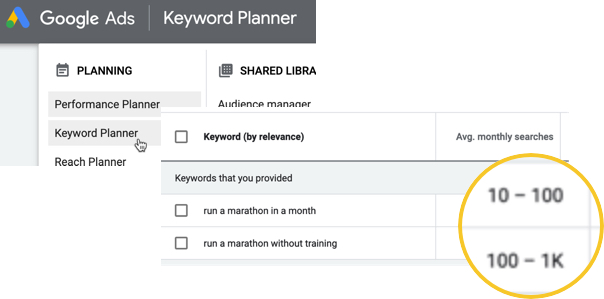
As shown here, run a marathon in a month has between 10 and 100 searches a month, whereas run a marathon without training has between 100 and 1,000.
In other words, the latter keyword has a ten-fold increase in potential demand.
Generally speaking, aim for keywords that are at least in the ‘100 - 1K’ range.
Use the Keyword Planner to find other possible keywords for YouTube videos.
A keyword showing a little further down the list showed ‘1K - 10K’ average monthly searches: 
So, once you’ve found a suitable keyword, it’s time to start planning your video.
Video Optimization Step #2: Planning and Creating Your Video
Many people make the mistake of only starting to think about video optimization after they’ve already created the video.
In truth, effectively optimizing videos for YouTube is a crucial part of the planning and creation process.
Many people only think about optimizing a video for YouTube after they've already created it. Instead, effective optimization starts a lot earlier in the process.Click To Post OnOptimize Your Video’s Spoken Content
Just as Google ‘reads’ text-based content like blog posts in order to rank it on search, YouTube also ‘listens’ to spoken words in your video.
The platform automatically transcribes speech in your videos into text, in part so it can then create subtitles (like in the example shown here), but also so it can effectively rank them.
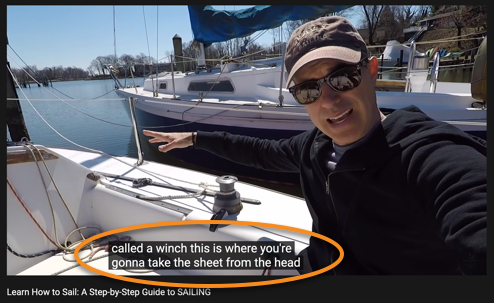
And of course this also extends into Google Search for videos too.
So imagine the words spoken in your video as a blog post. To rank it for certain keywords, you’d expect to see the keyword:
- Incorporated into the title.
- Somewhere, usually once or twice, in the first few sentences.
- Interspersed elsewhere in the content, including variations of the keyword (but keeping it natural and without overdoing it!)
- Ideally somewhere in your concluding paragraph too.
Approach your video in the same way.
Whether or not your video is scripted or ad lib, to rank effectively you need to be thinking about incorporating your keyword (and variations of it) throughout the spoken words of your video.
Optimize Your Video to Indicate High Value to YouTube
Just as with Google Search, YouTube wants to show content that represents the best value in response to a user’s search query.
The first step of course is to firstly ensure you provide as much value as possible to your audience in the videos you create.
Without that solid foundation, little else here will have much of an impact.
But you also need to bear in mind key ways to communicate that value to YouTube...
Create Videos for Maximum Audience Retention
If people stay and watch a video all the way through, it indicates to YouTube that it provided a high level of value and met their needs.
YouTube loves putting these videos higher up the listings because it generates more revenue for the platform:
- It provides more opportunities to display advertising during the video.
- It means people will watch other videos and return to YouTube, which translates into further advertising opportunities.
So a key factor for optimizing your videos is retention.
The longer you can retain viewers, the better optimized your video will be—so aim to create videos that keep viewers engaged for as long as possible.
Once your video is live, you can then examine how your video is performing via the analytics provided via YouTube Studio.
Click through on the analytics for your video and you may see something like the following:

This is reasonable, with a steady drop-off in viewership throughout the video, but there’s room for improvement in future videos.
Click the Dip link and YouTube will indicate a key point where viewers are skipping or abandoning your video, helping to inform your future videos.
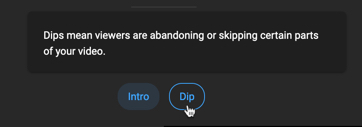
- According to Databox, “typical retention rates are slightly above 30%”.
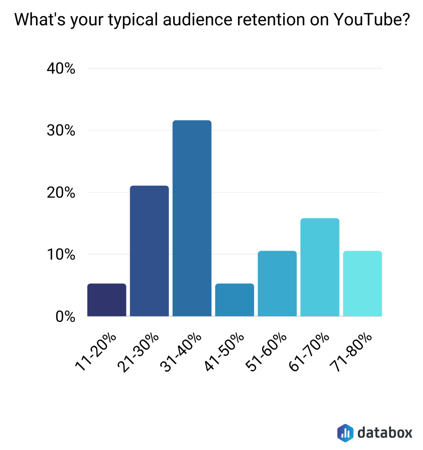
So beat that, and your chances of ranking well on YouTube rise.
Databox also suggest the following 9 ways to increase retention:
- Make use of video chapters—this helps audiences find what they need, increasing retention rates and overall watch times.
- Offer a sneak peek—try showing a preview of the content at the very beginning to help keep viewers hooked for as long as possible.
- Use keyword research to pick video topics—use keyword research, as discussed above, to ensure your videos reflect what people are actually wanting to know about.
- Use a script—a script helps perfect your messaging and storytelling, helping to engage your audience for longer.
- Post consistently—be consistent in how often you publish new videos, as well as their length and content. Consistency builds trust, and trust builds retention rates.
- Be concise—avoid “fluff” content. Instead, provide value and get to the point.
- Deliver value as quickly as possible—tell the audience what your video is about, and then quickly start delivering on the promise of the video’s title.
- Use onscreen graphics—videos that include on-screen graphics like images, cartoons and charts increase engagement and are proven to increase retention.
- Include pattern interrupts—this is the art of briefly breaking the flow of a video, forcing the viewer to pay more attention so they understand what’s happening, while maintaining their interest and engagement.
Encourage Viewers to Subscribe
Another key indicator of the value of your video is when someone subscribes to your channel.
After all, if someone’s watching a video and subscribes to the relevant channel as a result, they must have found the content not just valuable, but so valuable that they don’t want to miss further videos from that channel.
That’s a pretty powerful indication of a video’s value.
So the more viewers you can get to subscribe to your channel the better!
And that means planning moments in your video when you ask viewers to subscribe.
Most leave this until the very end yet, as we’ve seen, the average audience retention rate is slightly higher than 30%.
So experiment with:
- Asking viewers to subscribe right at the beginning of the video
- At some point in the middle, ideally at the point where their interest in your content is likely to be at its highest.
However, be as brief as possible—as simple as saying “remember to subscribe to our channel”, or simply adding a suitable graphic—so as not to interrupt the overall delivery of the video’s value to the viewer.
Video Optimization Step #3: Listing Your Video on YouTube
When optimizing videos for YouTube, uploading and listing it properly is only part of the process. Other optimization steps come before and afterwards.Click To Post OnWith your video now created, the third step in optimizing your videos properly happens when you upload it to YouTube.
Optimize the Meta Information
After starting to upload your video, you’ll be asked to enter various details. Here are the important bits that relate to optimization.
Title
The keyword you’re focusing on should be included in your video title.
If your keyword was 6 month marathon training plan, the title of your video might be The Ultimate 6 Month Marathon Training Plan. 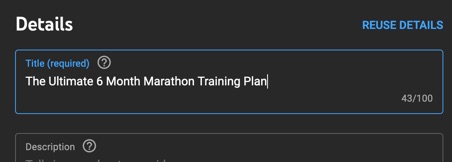
Remember you have up to 100 characters to play with here.
There might for example be one or more secondary keywords you want to add in after the main title to help indicate to YouTube what the video’s about and pick up some additional video views.
Description
Again, the keyword should be included in your description. The description field permits up to 5,000 words, which is of course considerable.
Depending on the length of the description you add, you’ll likely want to work in your keyword multiple times, using the exact keyword as well as variations of it.
Here’s what the start of a description might look like based on our example keyword: 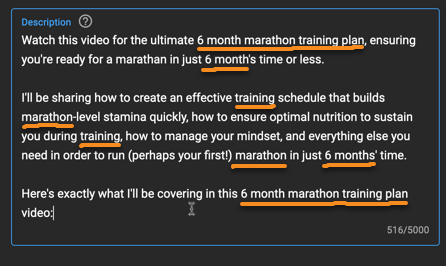
Notice how the exact keyword is incorporated a couple of times, alongside different words from that keyword used in different ways in the middle paragraph. As a result, YouTube should have little doubt as to what the video is focused on.
Tags
The tags in fact have minimal impact on the optimization of your video, but it’s best for good measure to simply add your main keyword alongside some related keywords. It takes little additional time to do.
Create an Optimized Custom Thumbnail
One of the most important aspects of listing your video on YouTube is its thumbnail.
This works in the same way as Google Search, where if Google sees more people clicking on a particular result, it will assume that it’s more relevant for a particular query and this can lead to a ranking increase.
In other words, an appealing thumbnail that attracts clicks can help your video to rank better.
Here are some example thumbnails for videos related to yoga, all of which have attracted at least a million views: 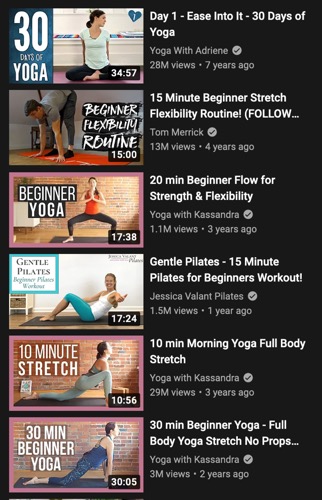
All of them feature:
- A human being—people love to connect with others, and it’s well known in advertising for example that including a picture of the human face can radically increase click-throughs.
- The video title or a relevant keyword in bold text.
With each one, you can tell with a quick glance what the video is all about, and that’s largely what you’re aiming for.
Check out this guide to creating custom thumbnails, or watch the following quick overview:
Optimize the Number of Viewers Who Become Subscribers
In Step #3, we talked about encouraging viewers to subscribe, and there are some key ways to do that using tools that YouTube gives you.
Add an End Screen
Firstly, an End Screen allows you to show a special overlay at the end of your video that promotes your other videos and, potentially, an opportunity for viewers to subscribe to your channel.
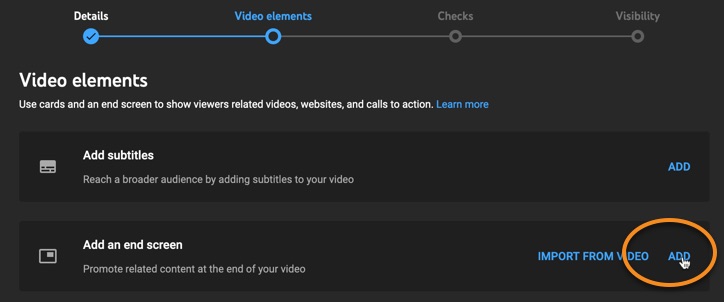
Select one of the options provided that includes ‘subscribe’:

By default, the elements of your End Screen will show for 20 seconds at the end of the video. They can be adjusted individually as required, with a minimum display time of 5 seconds.

When hovering over the subscribe element, a larger graphic is shown inviting the viewer to subscribe to your channel.
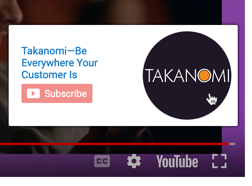
Here’s one of our videos where you can see this element (along with the others mentioned here) in action:
Add a Channel Card
Secondly, another YouTube-provided overlay you can add to your video is a card.

You can use cards to promote videos, playlists and channels. Members of YouTube’s Partner Program can also add link cards.
We’re going to be adding a channel card here to help optimize your video for subscribers, which is likely to be the most effective option to help your video rank well and attract more viewers.
It shows as a circled ‘i’ in the top right corner of the video, including some optional teaser text which will show for a few seconds at the start.
Clicking the card opens a side panel that promotes your channel, which the viewer can then click to visit it.
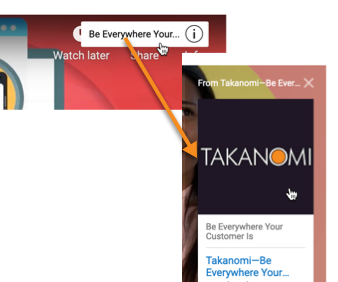
Essentially, it simply provides an additional opportunity for a viewer to subscribe.
To add one, select the Channel option, and then search for and select your own channel.
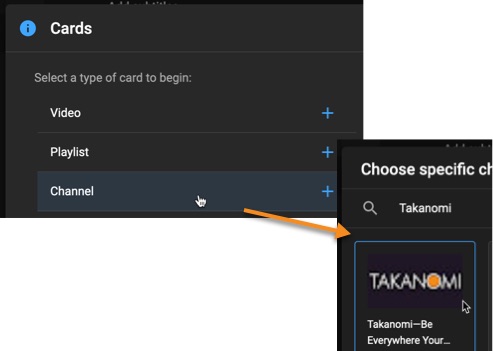
You can then optionally add a custom message (shown on the side panel), and some teaser text (shown briefly next to the circled ‘i’).
The card (the circled ‘i’) will be displayed throughout your video, though you can adjust the point at which the teaser text is shown by dragging it on the timeline.
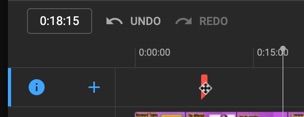
Add a Video Watermark
Thirdly, you can add a video watermark to videos on your channel. When viewers hover over it they are again encouraged to subscribe.
You only need to do this once, and it’s then applied to all the videos published on your channel.
To do so, click to customize your channel, and click on the Branding tab.
Upload an image 150px x 150px. This might simply reflect your brand, or you can choose to make it look like a subscribe button as shown here:
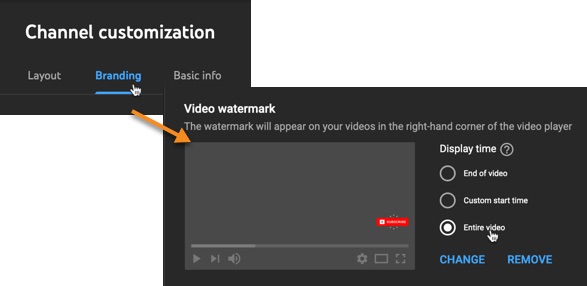
Select to show it for the entire video (recommended), just at the end, or at a start time of your choosing.
Here’s how it might look when a viewer then hovers over it:

Video Optimization Step #4: Promoting Your Videos
With your video now listed on YouTube, it’s tempting to think your work is now done!
But in many ways, what you do after it’s been listed is the most important part.
Optimizing your video for YouTube is not finished once it's uploaded and listed. Promoting your video afterwards is a crucial part of the optimization process.Click To Post OnIt’s now essential to start promoting your video to attract viewers, grow your channel subscribers, and help your video rank.
After all, the more people that view your video, the more data YouTube has to work with to help optimize its ranking.
Here are 8 different ways to start promoting your videos:
- Embed them into relevant blog posts—if you’ve repurposed your video from a blog post, one of the lowest hanging fruit is to embed the video back in that blog post! In addition, or otherwise, look for other posts where the content of the video has relevance and can add value. By doing this, you also help optimize those posts for SEO.
- Embed into relevant content on other content platforms—you can do this on Medium, Quora, within LinkedIn articles and elsewhere.
- Share them on social media, including with paid promotion.
- Include them in a regular business newsletter—this is common practice, with examples including newsletter from the Social Media Examiner and AWeber.
- Once you have several videos on your channel, use playlists to group similar videos together. When watching a playlist, viewers will automatically get the next one, bringing you a ton of extra views.
- Promote and optimize your channel page so that more people find your channel and watch more of your videos—for more info on doing this, see:
- Step #5 in this post on how to set up a YouTube channel for your business
- Step #5 (again) in this other post on how to grow your YouTube subscribers.
- Try sharing snippets of your YouTube videos on social media as native videos (doing so attracts higher organic distribution levels), displaying an easy-to-remember-and-type-in link on a call to action page at the end where they can view the full video on YouTube.
- Pay to promote them such as via YouTube Search Ads—here's a full guide.
As your videos start to attract views, you’ll likely attract comments too.
Be as active as you can in replying and otherwise engaging with those comments.
Doing so helps encourage future such comments, and an active community encourages people to subscribe to your channel. In turn, as we’ve discussed, that helps optimize your videos for YouTube.
Frequently Asked Questions
How can I optimize videos for YouTube effectively?
Start with keyword research, create engaging content, optimize spoken words, and use tools like End Screens to enhance viewer retention and subscriptions.
What are some key steps to optimize videos for YouTube?
- Keyword research for content creation. 2. Planning video content with spoken word optimization. 3. Listing videos properly with meta data and thumbnails. 4. Promoting videos for increased viewership.
Why is audience retention important for video optimization on YouTube?
High audience retention indicates valuable content to YouTube, boosting rankings and generating more ad revenue opportunities.
How can I increase subscriber conversions for my YouTube channel?
Use tools like End Screens, Channel Cards, and Watermarks to prompt subscriptions during and after videos.
What are effective ways to promote videos on YouTube?
Promote through blog posts, social media, newsletters, and other platforms. Use playlists, optimize channel pages, and engage with comments to enhance visibility.
To Conclude
This post has given you four key steps for optimizing videos for YouTube:
- Finding optimal keywords through effective keyword research
- Optimizing when planning and creating your videos
- Optimizing when uploading and listing your videos on YouTube
- And finally, promoting your videos effectively once published.
Put all of these into practice, and you’ll be ahead of most other video creators on YouTube.
